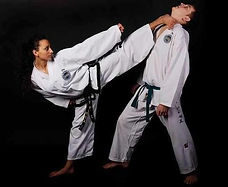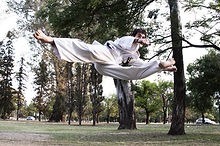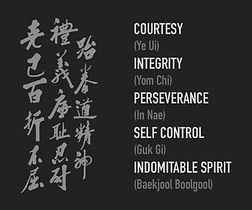
WC KMAC
West Coast Korean Martial Arts Centre
*Taekwon-Do * Haidong Gumdo* Fitness * Self Defense* Kids Tigers*

Welcome To ITF Taekwon-Do
Taekwondo is a Korean martial art with a heavy emphasis on kicks. Taekwondo was developed during the 1940s and 1950s by various Korean martial artists, as a blend of the indigenous Korean fighting styles of taekkyeon, gwonbeop, and subak, with influence from foreign martial arts, such as Karate and Chinese martial arts.
Contact us for Class Inquiries



What to expect from Mercury Taekwon-Do
Classes are high paced and detailed focusing on the development of your skills and ability





TKD (Taekwon-Do) in general is a very effective and powerful MA (Martial art). It has a very high emphasis on kicking, using obviously the legs which hosts the body’s strongest muscles. Also known as the world’s most popular MA and the leading authority in kicking MA’s.
A well placed kick will have devastating effects on an opponent and most likely incapacitate them.
However, Kicking is only a part of this flamboyant style of MA. ITF (International Taekwondo federation) TKD is also known for their destructive power and effectiveness in their hand techniques. Blocking, evading, grabs, grappling, throws, locks, pressure points, breathing and healing techniques build the TKD students arsenal into a truly efficient MA practitioners.
Now, there are many aspects of the ITF TKD curriculum that one needs to know to ensure the development of a good all rounded TKD practitioner. They are listed below:
-
Fundamental Movement – The basics of body mechanics.
-
Patterns – Various fundamental movements, Most of which represent either attack or defence techniques, set to a fixed and logical sequence.
-
Sparring – Physical application of attack and defence
-
Self-Defence – The ability to asses a situation and defend one’s self accordingly.
-
Conditioning – Building fitness, strength, speed, reflex, flexibility and mental stamina.


For juniors (Age 12 and younger)
Class is a duration of 45 min.
Each class will start with a warm up. Getting the body warm and heart pumping is essential. We achieve this by using games and warmup sequences that engage and keep all focused.
Followed by a short stretch. Necessary for muscle injury prevention.
There are many different themes that a class can take on any individual night. We always try and make is simple and fun, but without compromising our respect and discipline values. We will generally work on 2 to 3 of the following:
-
Fundamental Techniques – correct application of techniques
-
Pattern Training – essential for co-ordination, control, speed, reflex and power development.
-
Step Sparring – Controlled attack and defence.
-
Semi Free Sparring – Learning correct angle and distance.
-
Self Defence – Preparation for real life events like abductions, intimidation and bullying.
-
Special Techniques – Showing students what is actually possible with training.
Every night will have an abundance of theory as every movement is explained in detail to ensure all student understand the method and purpose. This will be explained in an easy to understand and concept grasping manner
For seniors (Age 13 and older)
Class is a duration of 60 min.
Each class will start with a warm up. Getting the body warm and heart pumping is essential.
Followed by a short stretch. Necessary for muscle injury prevention.
There are many different themes that a class can take on any individual night. We will generally work on 2 to 4 of the following:
-
Fundamental Techniques – correct application of techniques
-
Pattern Training – essential for co-ordination, control, speed, reflex and power development.
-
Step Sparring – Controlled attack and defence.
-
Semi Free Sparring – Learning correct angle and distance.
-
Free Sparring – Skill development for competition fighting.
-
Self Defence – Preparation for real life combat. Unarmed and Weapon Training.
-
Special Techniques – Developing super human ability.
-
Power Breaking – Breaking boards for Power development.
-
Conditioning – Preparing one’s body to react appropriately for any situation.
Every night will have an abundance of theory as every movement is explained in detail to ensure all student understand the method and purpose.
ITF Taekwon-do, also known as the International Taekwon-Do Federation style of Taekwon-do, holds several key aspects that make it valuable:
-
Practical Self-Defense: ITF Taekwon-do places a strong emphasis on effective self-defense techniques. It teaches students how to effectively strike, block, and evade attacks, equipping them with practical skills to protect themselves in real-life situations.
-
Comprehensive Training: ITF Taekwon-do encompasses a wide range of training components, including patterns (Tul), sparring, self-defense drills, breaking techniques, and conditioning exercises. This comprehensive approach helps students develop strength, flexibility, balance, coordination, and overall fitness.
-
Traditional Values and Philosophy: ITF Taekwon-do is rooted in traditional Korean martial arts values and philosophy. It promotes the development of discipline, respect, perseverance, and indomitable spirit. It emphasizes the cultivation of character alongside physical training, providing a holistic approach to personal growth.
-
Focus on Patterns: Patterns (Tul) are a significant component of ITF Taekwon-do. They are a series of choreographed movements performed against imaginary opponents, incorporating a variety of techniques and stances. Patterns enhance balance, coordination, concentration, and memory, while also preserving the traditional techniques and philosophies of Taekwon-do.
-
Global Recognition and Standardization: The International Taekwon-Do Federation (ITF) is a worldwide organization that governs and promotes ITF Taekwon-do. Its global recognition ensures a standardized curriculum, training methods, and grading system, providing consistency and quality across different schools and countries.
-
Competitive Opportunities: ITF Taekwon-do offers numerous opportunities for students to participate in local, national, and international tournaments. These events allow practitioners to showcase their skills, test their abilities, and engage in friendly competition. Participating in tournaments can foster personal growth, build confidence, and promote camaraderie among practitioners.
-
Lifelong Learning and Progression: ITF Taekwon-do provides a structured belt system, enabling students to progress through different ranks as they acquire knowledge, skills, and experience. The journey in ITF Taekwon-do is a lifelong one, with continuous learning and growth opportunities, fostering a sense of dedication and perseverance.
Overall, ITF Taekwon-do's practicality, holistic approach, traditional values, global recognition, and opportunities for personal growth and achievement make it a valuable martial art that contributes to physical fitness, self-defense, and character development.
The importance and value of martial arts
Training martial arts is important for several reasons:
-
Self-Defense: Martial arts provide practical self-defense skills that can help you protect yourself and others in real-life situations. Learning techniques to defend yourself can boost confidence and provide a sense of security.
-
Physical Fitness: Martial arts training offers a complete workout that improves strength, flexibility, cardiovascular endurance, and overall physical fitness. It challenges the body in various ways, promoting muscle development, coordination, and agility.
-
Mental Discipline: Martial arts cultivate discipline, focus, and mental resilience. Training requires dedication, perseverance, and the ability to push through challenges. These qualities extend beyond the training mat and can positively impact other areas of life, such as work, education, and personal relationships.
-
Stress Relief and Emotional Well-being: Engaging in martial arts allows you to release stress and tension in a controlled environment. The physical activity stimulates the release of endorphins, which can enhance mood and reduce anxiety. Additionally, the focus required during training can serve as a form of meditation, promoting mental clarity and emotional balance.
-
Social Interaction and Community: Martial arts often foster a sense of camaraderie and community. Training with others who share a similar passion creates a supportive environment, providing opportunities for personal growth and lifelong friendships.
-
Cultural Appreciation: Many martial arts have deep cultural roots and traditions. Training in a martial art exposes you to different philosophies, values, and histories, fostering a broader understanding and appreciation of diverse cultures.
Overall, training martial arts offers a holistic approach to personal development, encompassing physical fitness, mental discipline, self-defense skills, and a sense of community. It can positively impact various aspects of life, promoting overall well-being and personal growth.
